Lunar New Year, also known as Tet, is the most important and popular holiday on the Vietnamese calendar.
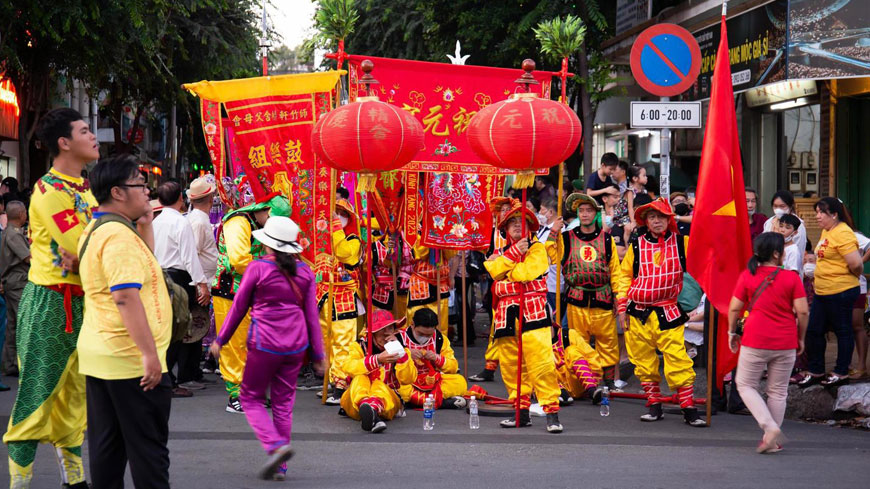
Saigon's streets during Lunar New Year - Photo :vecteezy
Introduction
The Lunar New Year, also known as Têt Nguyên Đán is the most important celebration in Vietnam. It is an opportunity for families to meet, to remember their ancestors and to welcome the new year with hope and joy, because the Vietnamese think that with the end of the year, bad luck stops to give way to a year of success, of joy and good health.
To satisfy your curiosity, know that the word Nguyen Dan comes from the Chinese, where Nguyen has the sense of « begining » and Dan, meaning « morning ». This is traditionally translated as early spring morning. As for the word Tet, it comes from a Chinese-Vietnamese term meaning "feast."
A short history of the soli-lunar calendar
Tet takes place every year between mid-January and mid-February of the lunar calendar.
It is this calendar that indicates the dates of the traditional festivals in Vietnam, the solar calendar being used for everyday life. For the record, the lunar calendar was created under the Chinese emperor Huang Di in the year 2637 BC, during its 61st year of reign. Since then, in China as in Vietnam, this calendar has remained the reference to celebrate the holidays and especially the new year.
Vietnamese Lunar New Year is not Chinese Lunar New Year
Although of Chinese origin, the Vietnamese soli-lunar calendar departs from it sharply, especially in the dates of the beginning of the lunar phases. It is the time lag (- 1h) between Péking and Hanoi that creates a gap that can range from a day to a month. This explains the years of 13 moons, or embolismic years: as for the Roman calendar (Gregorian), the lunar breaks down into 12 months covering 354 days. To make up the 11 days of difference with the Gregorian, we will add one intercalary month every three years, between 3rd and 4th lunar month. And to be complete, let us specify that each Vietnamese hour equals two western hours, a period of time governed by one of the 12 animals of the local zodiac, which also differs slightly from that in use in the Middle Empire (the fourth sign of the zodiac in Vietnam is the cat while it is the rabbit in China).
In 2024, on February 10, we will enter the year of the dragon.
► You may be interested by : Unveiling Irresistible Tourist Allure: Why Vietnam?
History of the Lunar New Year
This festival dates back to the first days of the installation of the first Vietnamese in the Red River Delta, an area that will become a major rice-growing region in Vietnam, in the north of the country. Tet was the beginning of a new cycle of cultivation. Over time, agricultural roots have gradually become a deeply rooted cultural tradition.
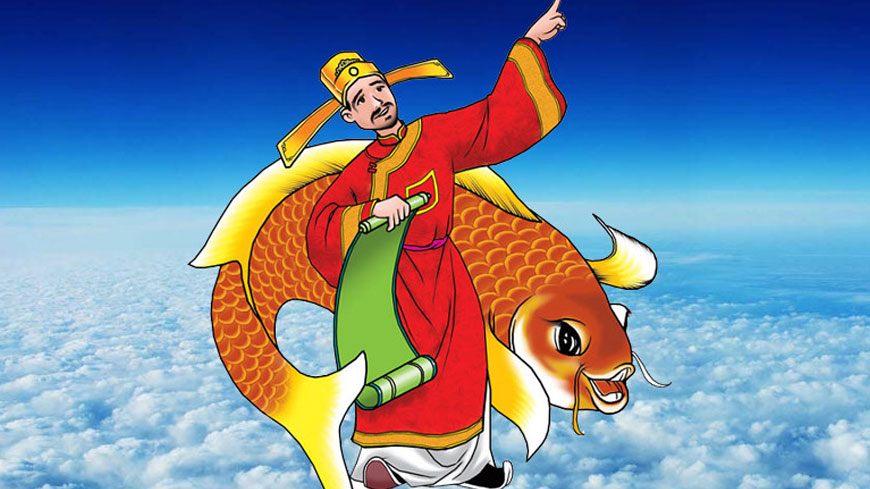
Ong Tao reports back to the Jade Emperor - Picture : Internet
Lunar New Year Celebrations
Ong Tao reports back
At the beginning of Tet, on December 23 of the lunar year, the genius of the kitchen called Ong Tao rides a carp to find the Jade Emperor and make his report to him. If Ong Tao’s mission is to take care of the kitchen and the family, once a year, he is asked to report to the Jade Emperor what happened in the homes during this past year. With the idea that he would write a glowing report, the family prepared offerings in the form of sweet food and fruit. After Ong Tao’s departure, people begin to tidy, repaint and clean their homes.
The preparations
Throughout Vietnam, preparations for Tet begin two to three weeks in advance, with cleaning, decorating and beautifying the house. We buy new clothes, we go to the hairdresser, we buy flowers, we decorate the altar of the ancestors, we wash the vehicles Each house and each office is decorated with banners bearing the inscription Chuc Mung Nam Moi! Happy New Year. Inside, there is a kumquat, a symbol of prosperity. The name «kumquat» comes from the Cantonese word gam-gwat [gām-gwāt], which literally means «golden orange». Small precision regarding the traditional flowers of Tet: in the North, you will see mainly branches of peach (the pink symbolizing love and joy), while the South prefers the golden yellow of apricot trees (ochna), symbol of luck and prosperity.
Custom Day Ma (Tao Mo)
On December 24 of the lunar year, the Vietnamese will clean the tomb of their ancestors. They remove weeds, repaint the grave and pray.
The day before the Tet
With the approach of Tet, the hustle and bustle is at its height in the streets of Vietnamese cities where colorful shrubs are transported to the back of motorcycles: a unique festive spirit, a mixture of religious fervour, human warmth and commercial fever has seized the whole country! The Vietnamese also remember to buy the Bao li xi, these lucky red envelopes that are usually offered by the elders to younger family members (or by managers to employees)… after having been previously filled with a few new year gifts! Did you know? It is a sign of maturity for young Vietnamese to stop receiving these envelopes and start giving them. And above all, we cook. Many. We will have started well before the fateful date!
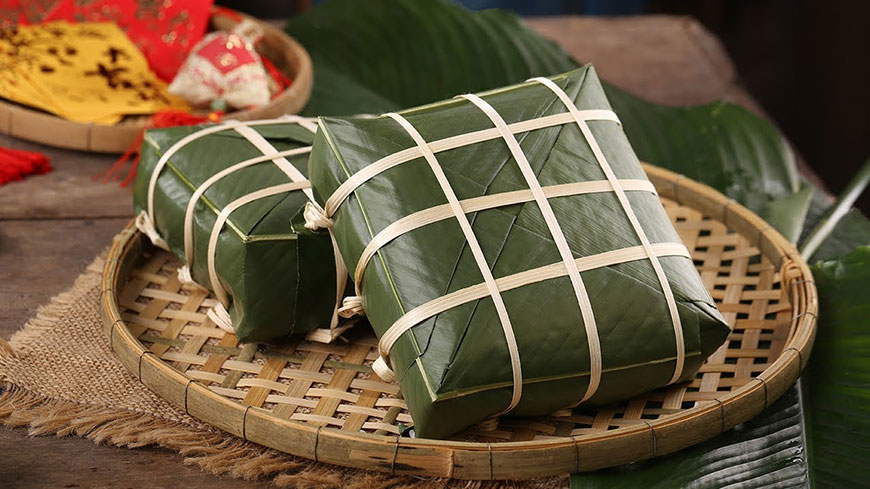
Traditional Banh Chung - Photo : Internet
Culinary specialties of the Lunar New Year
After cleaning the house from top to bottom, the whole family devotes themselves to cooking, especially preparing the famous banh chung (moon cake) in the North, and banh tet in the South. They will first be presented on the altar of the ancestors, before being eaten together. Each region has its own specialties for Tet:
In the North, we enjoy
• banh chung (sticky rice cake with pork)
• cha lo (pork sausage)
• thit dong (pork with mushrooms and pepper)
• candied lotus seeds
• candied ginger
In Central Vietnam, they prefer to share the:
• banh chung
• banh tet (sticky rice cake with pork with peas)
• pork
• chicken
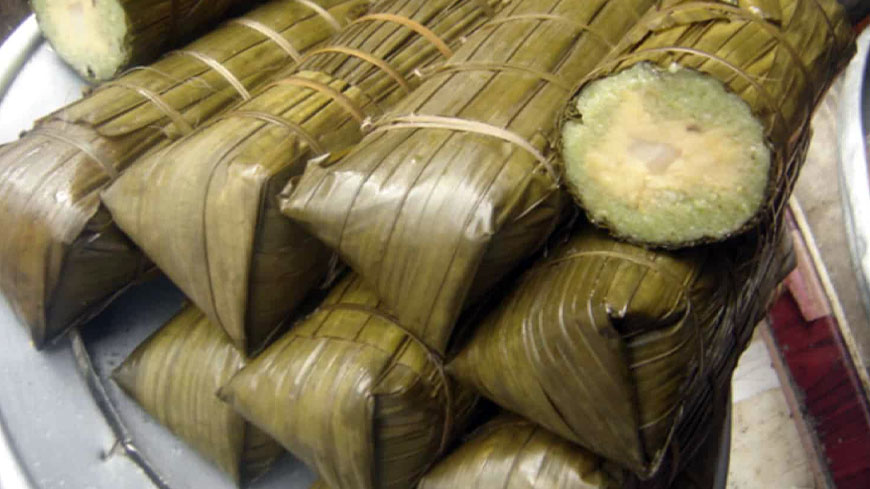
Traditional Banh Tet - Photo : Internet
In southern Vietnam, people will eat more readily:
• Thit kho (pork with eggs)
• cha gio (nems)
• pork soup
• chicken
• watermelon seeds
But everywhere you will find a plate of five kinds of fruit:
• pineapple
• coconut
• papaya
• mango
• soursop
As a symbol that there will be enough money to live for the new year. Some families have their own decoration with sticky rice wine, cakes, chocolates…
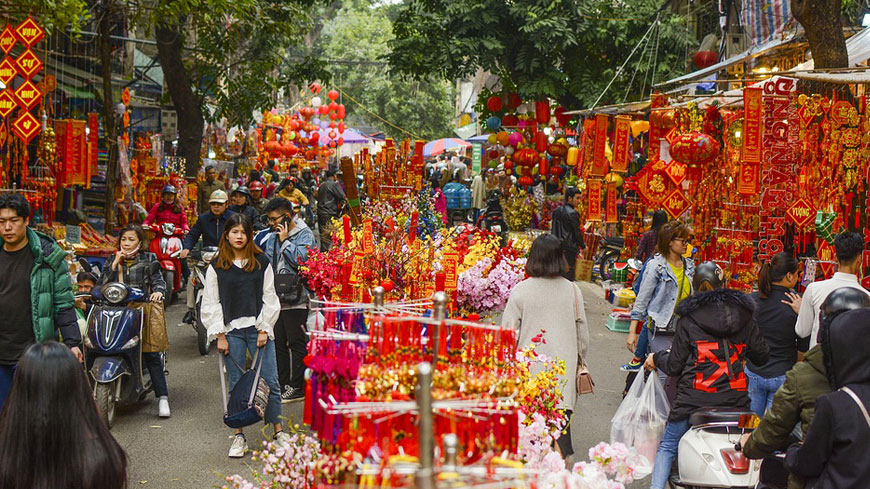
Hanoi's streets during Lunar New Year - Photo : pixabay
The Tham Vieng Custom
On the first day of Tet, the Vietnamese visit the family on the paternal side.
On the second day of Tet, the Vietnamese visit the family on the maternal side.
On the third day of Tet, some visit their teachers or their children’s teachers. Then they visit their friends to wish them a happy new year, eat and drink.
The Vietnamese Lunar New Year nowadays
With the changing times, the celebrations of Tet have changed. However, despite the influence of modernity, the essence of Tet - spending time with the family and celebrating life - remains unchanged.
A few words to conclude
Tet is more than just a celebration; it is a bond that unites Vietnamese with their past while welcoming the future with optimism.